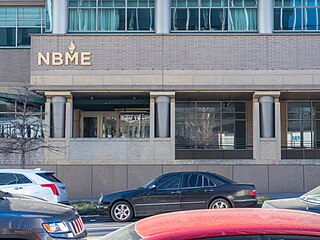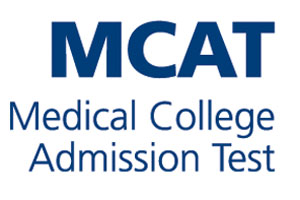The United States Medical Licensing Examination (USMLE) is a three-step examination program for medical licensure in the United States sponsored by the Federation of State Medical Boards (FSMB) and the National Board of Medical Examiners (NBME). Physicians with a Doctor of Medicine (MD) degree are required to pass the USMLE for medical licensure. However, those with a Doctor of Osteopathic Medicine degree (DO) are required to take the COMLEX-USA (COMLEX) exams.
According to the US Department of Education, the Educational Commission for Foreign Medical Graduates is "the authorized credential evaluation and guidance agency for non-U.S. physicians and graduates of non-U.S. medical schools who seek to practice in the United States or apply for a U.S. medical residency program. It provides comprehensive information and resources on licensure, the U.S. Medical Licensure Examination (USMLE), residencies, and recognition."
The United States Medical Licensing Examination (USMLE) Step 1 is a standardized test that assesses a medical student's knowledge of basic science concepts and their application to clinical medicine. The exam is one of three components required for medical licensure in the United States and is typically taken by students after their second year of medical school.
USMLE Step 2 CK is a nine-hour-long exam that represents the second part of the United States Medical Licensure Examination. It assesses clinical knowledge through a traditional, multiple-choice examination divided into eight 60-minute blocks, each containing up to 40 questions, as well as an hour of break time. In contrast to USMLE Step 1, which prioritizes knowledge of basic sciences, the focus of Step 2 is on clinical application of medical knowledge, and requires the examinee to apply medical knowledge, skills, and understanding of clinical science essential for the provision of patient care under supervision. The USMLE Step 2 is generally taken during the third or fourth year of medical school by U.S. medical students. Step 2 results are reported numerically on a scale between 1 and 300; this is in contrast to Step 1, which is pass/fail only.
An objective structured clinical examination (OSCE) is an approach to the assessment of clinical competence in which the components are assessed in a planned or structured way with attention being paid to the objectivity of the examination which is basically an organization framework consisting of multiple stations around which students rotate and at which students perform and are assessed on specific tasks. OSCE is a modern type of examination often used for assessment in health care disciplines.
The Comprehensive Osteopathic Medical Licensing Examination of the United States (COMLEX-USA) is a series of three osteopathic medical licensing examinations administered by the National Board of Osteopathic Medical Examiners (NBOME) similar to the United States Medical Licensing Examination (USMLE). COMLEX-USA is the most common pathway by which osteopathic physicians (D.Os) apply for medical licensure, and is accepted in all 50 states. The 3-digit standard scores of COMLEX-USA Level 1, Level 2- Cognitive Evaluation (CE), and Level 3 have a range of 9-999 and a mean of 500. Most candidates score between 250 and 800. 400 is the minimum passing score for COMLEX-USA Levels 1 and 2; 350 for COMLEX-USA Level 3. It was announced on January 24, 2022 that the COMLEX-USA Level 1 examination will be moving from a 3-digit numeric score to solely pass/fail beginning on May 10, 2022.
In health care, a simulated patient (SP), also known as a standardized patient, sample patient, or patient instructor, is an individual trained to act as a real patient in order to simulate a set of symptoms or problems. Simulated patients have been successfully utilized for education, evaluation of health care professionals, as well as basic, applied, and translational medical research.
An international medical graduate (IMG), earlier known as a foreign medical graduate (FMG), is a physician who has graduated from a medical school outside of the country where he or she intends to practice. The term non-local medical graduate may be similarly used in countries with distinct licensing regions within them. Generally, the medical school of graduation is one listed in the World Directory of Medical Schools (WDOM) as accredited by the Foundation for Advancement of International Medical Education and Research or the World Health Organization.

The Naturopathic Physicians Licensing Examinations (NPLEX) are professional licensing exams administered by the North American Board of Naturopathic Examiners (NABNE). Graduates of naturopathic programs accredited by the Council on Naturopathic Medical Education (CNME) are required to pass the exams before being permitted to practice naturopathic medicine in a U.S. state or Canadian province that licenses naturopaths.
The American University of Integrative Sciences (AUIS), is a private for-profit offshore medical school with a single campus located in Barbados. Founded in 1999, it was formerly known as the University of Sint Eustatius School of Medicine (USESOM). For a period, the school was based in Sint Maarten, where it was taken over by IEMR LLC, a US-based company. Since October 2017, AUIS has operated in Barbados, and it is currently a candidate for accreditation by the Caribbean Accreditation Authority for Education in Medicine and other Health Professions (CAAM-HP). As of January 2024, the university is facing closure due to financial insolvency.
Step 3 is the final exam in the USMLE series of examinations. It is part of the licensing requirements for Doctors of Medicine (M.D.), including international medical graduates aiming to practice medicine in the United States. Generally, it is a pre-requisite of the majority of the state licensing boards.
The Federation of State Medical Boards (FSMB) of the United States is a national non-profit organization that represents the 71 state medical and osteopathic boards of the United States and its territories and co-sponsors the United States Medical Licensing Examination. Medical boards license physicians, investigate complaints, discipline those who violate the law, conduct physician evaluations, and facilitate the rehabilitation of physicians where appropriate. The FSMB's mission calls for "continual improvement in the quality, safety and integrity of health care through the development and promotion of high standards for physician licensure and practice."

Aureus University School of Medicine is a private university located in Oranjestad, Aruba. Aureus confers upon its graduates the Doctor of Medicine (MD) degree.
The United States Medical Licensing Examination score (USMLE score) is given to test takers as a 3-digit score. This score is commonly used by hospitals to determine eligibility for residency and fellowship. The three-digit score is based on a theoretical maximum of 300, but this has not been documented by the NBME / FSMB. Previously, a 2 digit score was also provided, but has since been eliminated. The two-digit score was normalized to the three-digit score such that a 75 was equal to the minimum passing score (currently 194) for the USMLE Step 1. Contrary to popular opinion, the two-digit score does not represent a percentile.

Humayun Javaid Chaudhry, D.O., MACP, FRCP (Lon.), FRCP (Edin.) is an American physician and medical educator who is president and chief executive officer of the Federation of State Medical Boards (FSMB) of the United States, a national non-profit organization founded in 1912 that represents the 70 state medical boards of the United States and its territories and which co-sponsors the United States Medical Licensing Examination (USMLE). From 2007 to 2009, he served as Commissioner of Health Services for Suffolk County, New York, the state's most populous county outside New York City. In 2016, he was listed by Modern Healthcare magazine as one of the 50 Most Influential Physician Executives and Leaders.

The National Board of Medical Examiners (NBME), founded in 1915, is a United States non-profit which develops and manages assessments student physicians. Known for its role in developing the United States Medical Licensing Examination (USMLE) in partnership with the Federation of State Medical Boards (FSMB), USMLE examinations for medical students and residents are used by medical licensing authorities in the U.S. to help determine qualifications to grant and recognize medical licenses. NBME also creates assessments and materials that are used by medical students, medical educators, practicing physicians, and for state testing of physicians already holding licenses.

Howard S. Barrows was an American physician and medical educator who was Professor Emeritus at the Southern Illinois University School of Medicine where he had previously served as Associate Dean for Educational Affairs and Chair of Medical Education. Trained as a neurologist, Barrows is best known today for his many innovations in medical education, particularly teaching using Problem-Based Learning (PBL), developed while he was a professor at McMaster University Medical School, assessing clinical skills using simulated patients, and studying clinical reasoning using stimulated recall techniques.

The Medical College Admission Test is a computer-based standardized examination for prospective medical students in the United States, Australia, Canada, and the Caribbean Islands. It is designed to assess problem solving, critical thinking, written analysis and knowledge of scientific concepts and principles. Before 2007, the exam was a paper-and-pencil test; since 2007, all administrations of the exam have been computer-based.
St. George's University School of Medicine is the medical school of St. George's University located in St. George's, Grenada. The school was founded by Charles R. Modica on July 23, 1976. Because of its size, the school placed more doctors into first-year US residency positions than any other medical school in the world between 2011 and 2012. It was rated by The Princeton Review as one of the "Best 168 Medical Schools" in 2012. There are 158 accredited MD-granting institutions in the United States.
Edithe J. Levit was an American medical educator who served as president of the National Board of Medical Examiners from 1977 to 1986. She reformed the process of assessing doctors' clinical competence using standardized tests rather than subjective bedside observation.





